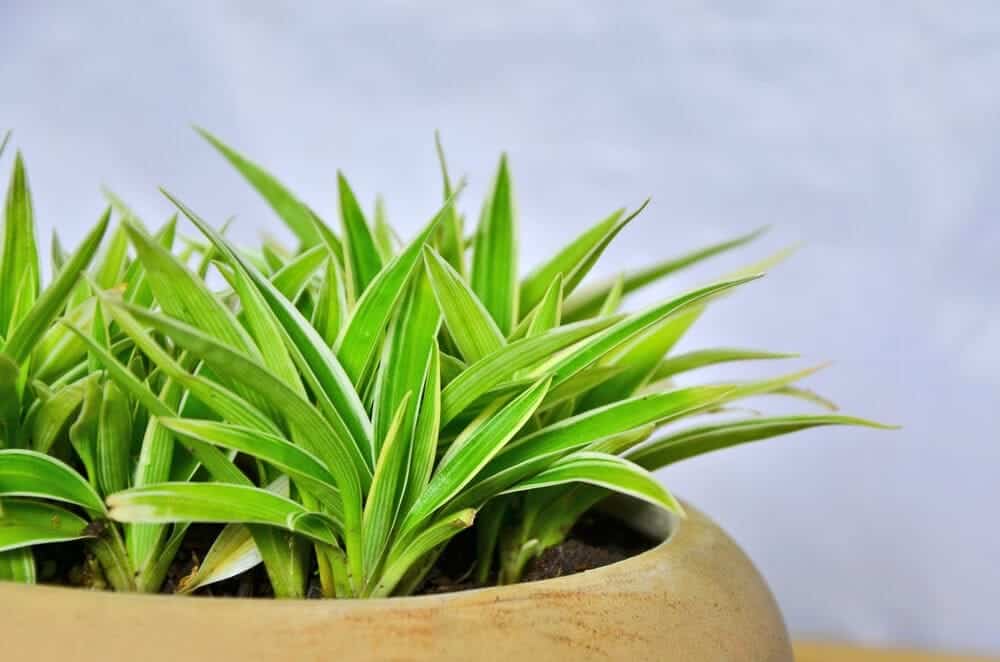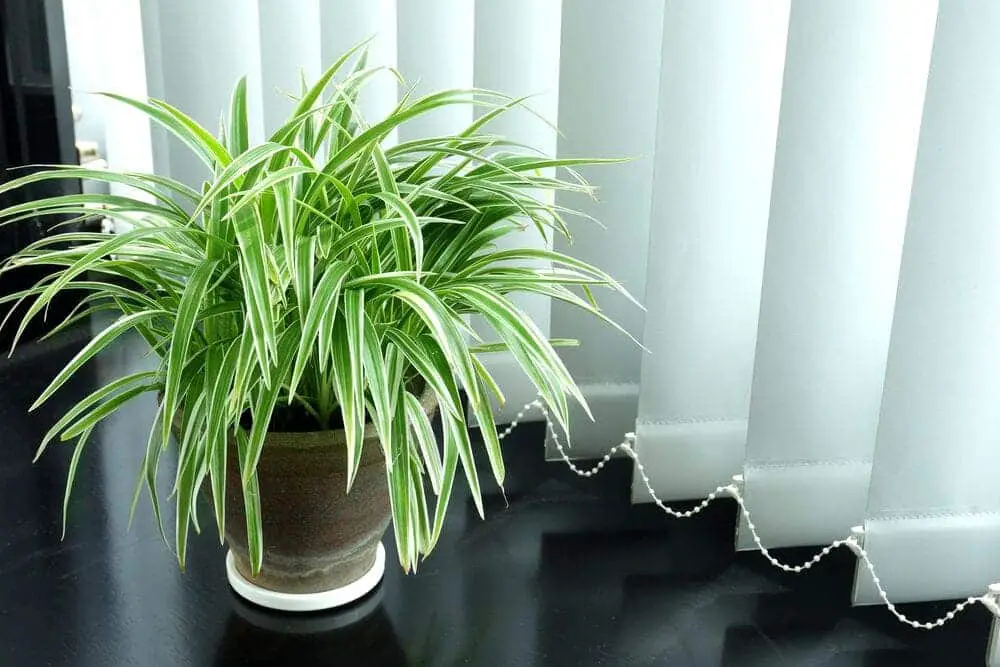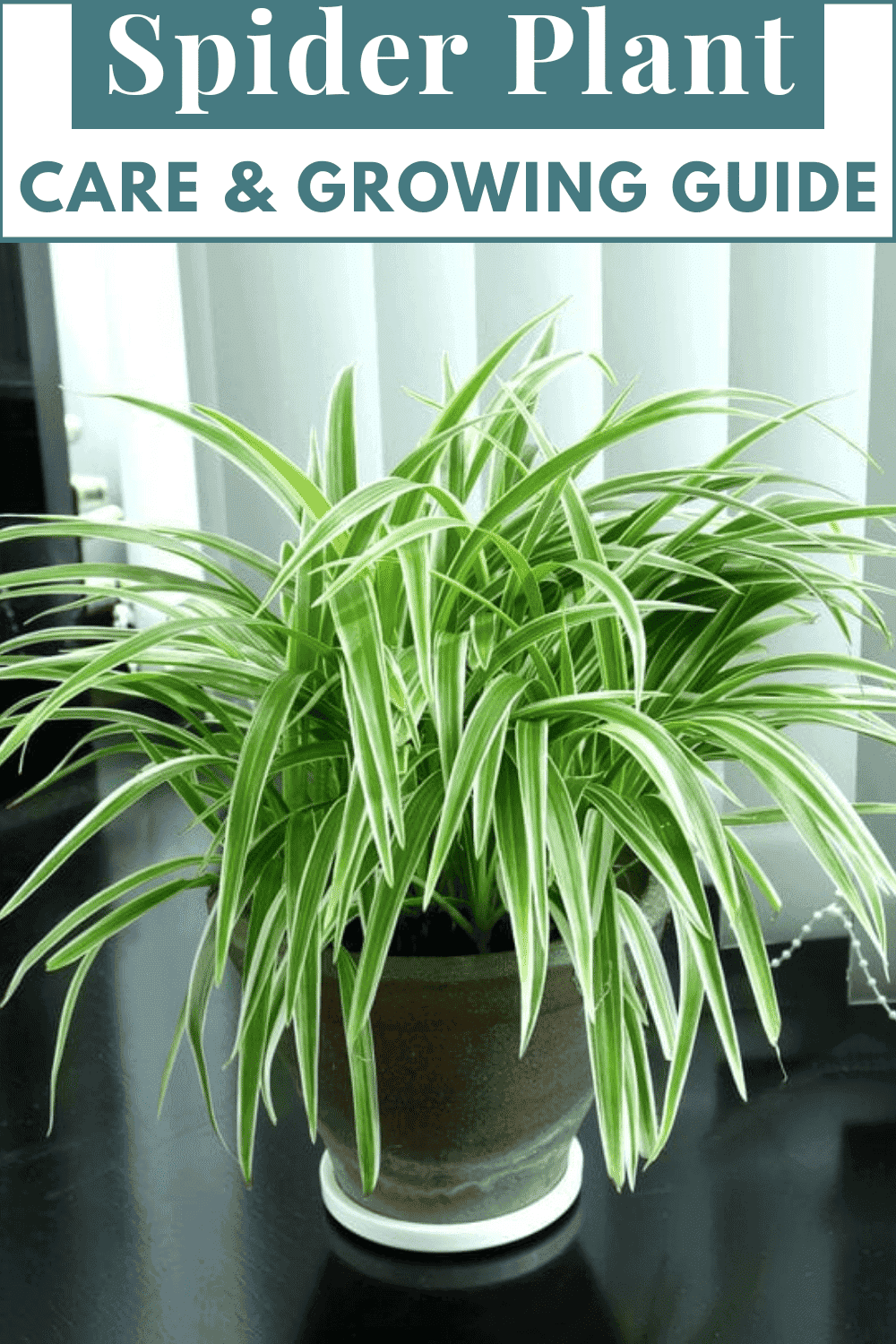The spider plant is named this because of its long dangly leaves that look like spider legs.
It is a trendy house plant around North America. Although rare, this plant can produce flowers if the conditions are right and the flowers look like baby spiders. Propagating this plant is easy, as offset bulbs quickly grow from the root ball.
Spider Plant Care & Growing Guide
1. Light Requirement
Spider plants need bright light, and they do well under direct sunlight too. They can be in shady areas or indoors, but less light will affect its growth rate and the growth of its leaves. The spider plant also does well under artificial greenhouse light.
2. Water
Watering this plant depends on how old it is. During its first year of life, the soil must be kept moist constantly. When it reaches maturity, it needs less water and benefits from the soil drying out a bit between watering. Before watering a mature plant, check to make sure the first inch of soil is dry, and then it can be watered.

3. Climate and Temperature
This plant does not like extreme cold weather, snow, or frost. It should be in environments where the temperature is between 65 and 75 F. If the weather is too cold, which is lower than 35 degrees F, its leaves will curl and brown. If the temperature is between 35 and 65 F, the plant will be fine, but its growth rate will slow.
4. Soil
Like most plants, this spider plant needs to be in well-draining soil. You can add a bit of fertilizer, but not often. The soil must be checked daily to make sure it is dry enough to be water. Since this plant forms tuberous roots in the soil, make sure the container it’s in is large and doesn’t pack the roots and tubers together.
5. Repotting
Because of the fast growth rate of this plant, you will have to repot it at least once a year. The spider plant likes its roots to be crowded. So when you change it to a larger pot, make sure it’s not too big. Repotting is simple; just remove it from its current pot, shake it gently to remove excess soil and repot it with fresh new soil that has humus in its mix.
6. Speed of Growth
How fast spider plant grows depends on how old it is. Young plants will grow quickly in their first year of life. When it reaches maturity, the spider plant technically slows down. But compared to other plants, they are still very fast growers. Leave them in an area where they have room to grow and won’t be crowded by nearby objects.
7. Height and Spread
Usually, people who own spider plants allow them to grow two feet wide and 3 feet long. But they can grow longer if they are left alone and not trimmed.

8. Trimming
This plant grows so fast and produces many baby plants. If it’s not trimmed regularly, it can quickly absorb all the nutrients in the soil without you knowing and suffer from malnutrition.
Trim off all offset plants that are beginning to grow, and trim off the longest leaves, plucking them from the main stem. Always trim any dead or disease foliage. You can trim this plant all year round; just keep them watered. If it needs a lot of trimming, don’t do it all at once. Too much trimming can cause shock.
Is the Spider Plant plant poisonous?
No, the spider plant is not poisonous to either humans or pets. However, cats and dogs actually like the taste of spider plants and will eat them if they can reach them from their planter. The foliage is not meant to be eaten, so you’re animal may get sick. Keep the spider plants away from where cats and dogs don’t have access to it.
Can Spider Plant Grow in Water?
Yes, the spider plant can live in and even thrive in water. Its water must be changed out every ten days, and it has to be given liquid nutrients. The water must be distilled and without fluoride. It is best if you condition a new baby spider plant to grow in water instead of trying to force adapt a mature plant to grow in water.
Does the Spider Plant have flowers, and how do I get them to bloom?
Yes, the spider plant has white flowers that bloom in the summer. After the flowers fall off, the remaining plant can be used to propagate and make new plants. To bloom, the flowers of the spider plant need a lot of sunlight and not be crowded by too much foliage.
Common Spider Plant Disease
- Brown Leaf tips occur when there is too much salt buildup in the soil. This is caused by fluoride in the water.
- To get rid of the excess salt in the soil must be flushed out with purified water or rainwater.
- Scale bugs are common pests to this plant, especially if it is indoors. Scale bugs are small brownish-yellow bugs that feed off of the spider plant, eventually killing it’s by robbing it of its nutrition.
- To get rid of scales, first, dispose of all intestine branches and leaves. Then spray organic pesticides over the plants to kill its larva. You’ll have to do this several times. Do this outside as the insecticide will cause the scale bugs to scatter to try and escape the spray. Use neem oil if you’re worried about the health of your plant. It is gentle on plants but can kill scales.
- Fungal root rot can affect a spider plant if it is water too much, and the soil is saturated. The plant turns brown at the base of its leaves, and they will eventually die out. The rot can turn it brown and smelly.
- To fight root rot, replace cut off all dead and moldy foliage first. You may have to take your plants out of the container and cut off rotten roots. Clean out the container and throw away the old infested soil, add new soil and place the plant back in its new soil.
Also read: Can Spider Plants Live Outside? Will They Survive?
Conclusion
- Brown leaf tips mean that there is too much salt in the soil.
- Its scientific name is the Chlorophytum
- Spider plants are very fast growers
- This plant has flowers that might bloom if conditions are right
- Not many diseases affect spider plants. However, it is prone to rot if its roots are overwatered.
- This plant is from South Africa.

Victoria is the owner and main author of hobby plants. She loves spending her free time in her garden planting and taking care of her plants. Victoria hopes you enjoy the content here!

![Mother Of Thousands Plant [Complete Plant Care Guide] Mother Of Thousands Plant [Complete Plant Care Guide]](https://www.hobbyplants.com/wp-content/uploads/2022/07/mother-of-thousands-plant-300x158.jpg)
![Majesty Palm Plant Care: [Complete Beginner's Guide] Majesty Palm Plant Care: [Complete Beginner's Guide]](https://www.hobbyplants.com/wp-content/uploads/2022/08/majesty-palm-care-300x158.jpg)
![Exotic Angel Plant Care: [Complete Beginner's Guide] Exotic Angel Plant Care: [Complete Beginner's Guide]](https://www.hobbyplants.com/wp-content/uploads/2022/08/exotic-angel-plant-care-300x158.jpg)
![Snow White Waffle Plant: [Complete Care Guide] Snow White Waffle Plant: [Complete Care Guide]](https://www.hobbyplants.com/wp-content/uploads/2022/08/snow-white-waffle-plant-300x158.jpg)
![Waffle Plant Care: [Complete Beginner's Guide] Waffle Plant Care: [Complete Beginner's Guide]](https://www.hobbyplants.com/wp-content/uploads/2022/08/waffle-plant-300x158.jpg)
![Bird Of Paradise Plant Care: [Complete Beginner's Guide] Bird Of Paradise Plant Care: [Complete Beginner's Guide]](https://www.hobbyplants.com/wp-content/uploads/2022/08/bird-of-paradise-plant-300x158.jpg)
![Purple Passion Plant Care: [Complete Beginner's Guide] Purple Passion Plant Care: [Complete Beginner's Guide]](https://www.hobbyplants.com/wp-content/uploads/2022/08/purple-passion-plant-care-300x158.jpg)
![China Doll Plant Care: [Complete Beginner's Guide] China Doll Plant Care: [Complete Beginner's Guide]](https://www.hobbyplants.com/wp-content/uploads/2022/09/china-doll-plant-care-300x158.jpg)
![Polka Dot Plant Care: [Complete Beginner's Guide] Polka Dot Plant Care: [Complete Beginner's Guide]](https://www.hobbyplants.com/wp-content/uploads/2022/09/polka-dot-plant-300x158.jpg)
![Mona Lisa Lipstick Plant Care: [Complete Beginner's Guide] Mona Lisa Lipstick Plant Care: [Complete Beginner's Guide]](https://www.hobbyplants.com/wp-content/uploads/2022/09/lipstick-plant-mona-lisa-300x158.jpg)
![Yucca Cane Plant Care: [Complete Beginner's Guide] Yucca Cane Plant Care: [Complete Beginner's Guide]](https://www.hobbyplants.com/wp-content/uploads/2022/09/yucca-cane-plant-care-300x158.jpg)